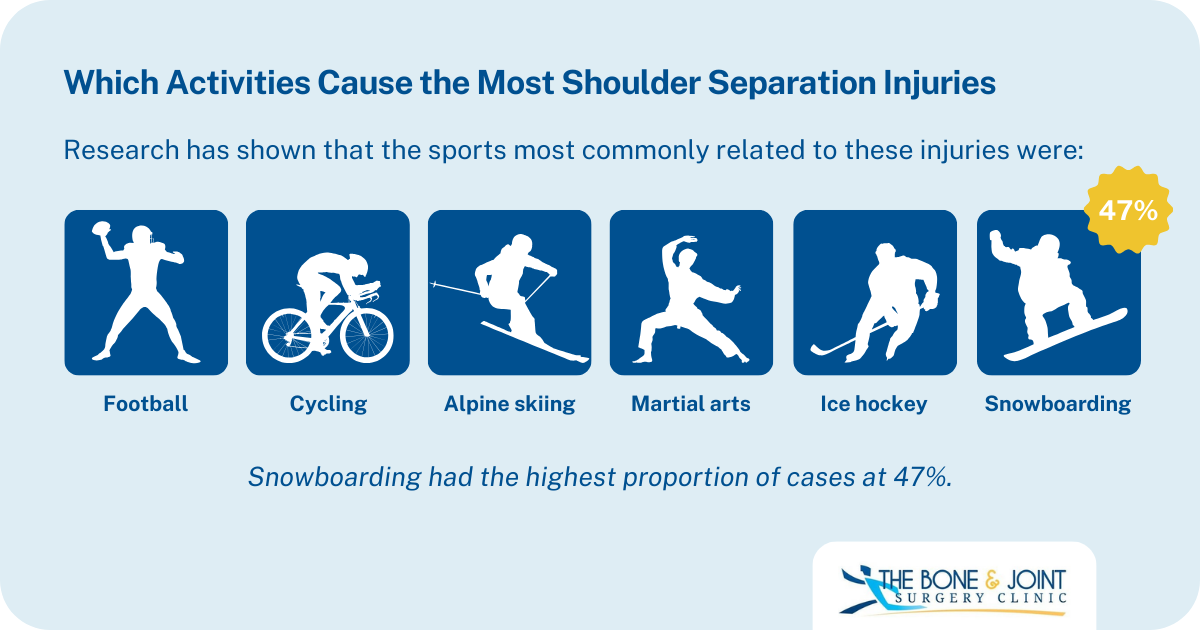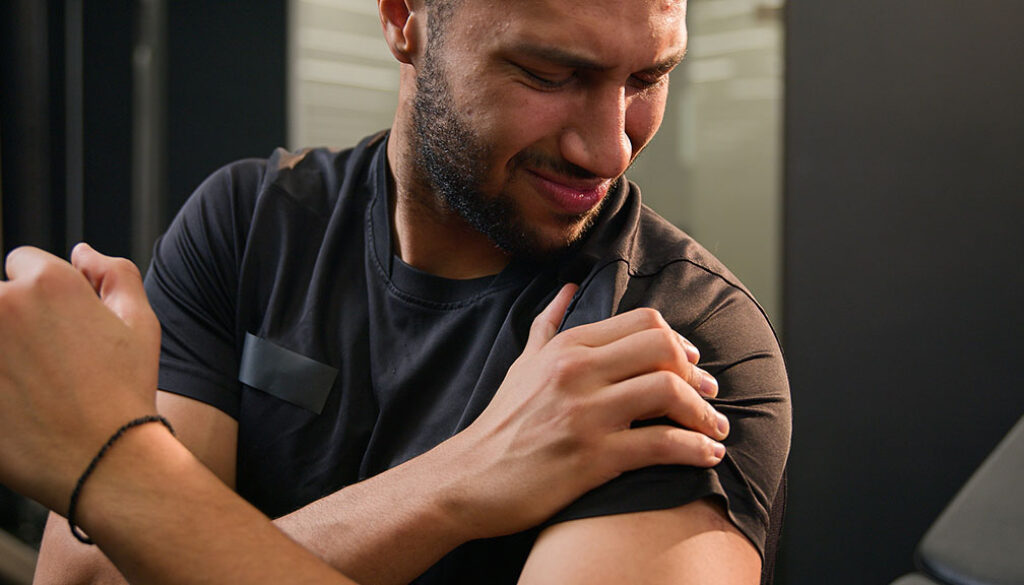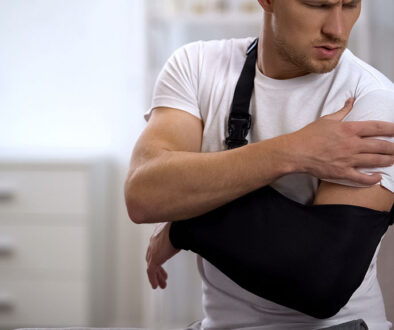What Causes a Separated Shoulder? 5 Facts You Need to Know
In this article:
When your favorite football receiver makes a perfect catch, dives to get the ball, and turns the game in your favor, you’re thrilled. But this player’s action sets the stage for a potentially serious shoulder injury.
If you have pain from a fall or a sports accident where you landed hard on the outside of your shoulder, you may have separated it. While there are different severities of this injury, it always requires careful examination by one of our experienced orthopedic surgeons in Raleigh.
If you have pain, limited movement and swelling, we’ll need to evaluate you to see if you have separated your shoulder. While many recover from this injury easily, in other cases, it may require surgery.We take a conservative approach to medicine. This means we will not perform surgery unless it is absolutely necessary. If you do need surgery, you can take comfort in the fact that we utilize the latest minimally-invasive techniques with revolutionary state-of-the-art technology.
We’ll take a closer look at what causes a separated shoulder as well as the information you need to know to be an active partner in your healthcare.
What Causes a Separated Shoulder? 5 Facts You Need to Know
A separated shoulder is caused when the ligaments that connect your shoulder blade to your collarbone are damaged by falling directly on the outside of your shoulder. A separated shoulder is often the result of an accident, injury, or participating in high-risk sports such as football, skiing or rugby, where falls are more frequent and often more severe.
We’ll quickly look at five facts you need to know about a separated shoulder and then delve into each one in a bit more detail.
1. Young Men Who Play Certain Sports Are At Greater Risk of a Separated Shoulder
What are the most common at-risk activities for separated shoulder injuries?
More than half of separated shoulders are due to sports injuries. Research has shown that the sports most commonly related to these injuries were:

Studies have also found that those with shoulder separation injuries are often younger men. One in 10 of all shoulder injuries were separated shoulders. Of those separated shoulder injuries, more than half were due to sports accidents.
2. Age Can Also Cause Separated Shoulders
While injuries account for the majority of separated shoulder injuries, there are other influential factors. As you age, your ligaments can weaken, opening the door for this shoulder injury. In addition, those who work in manual labor jobs who have to complete repetitive motions are at greater risk for the condition.
3. There Is a Difference Between a Dislocated vs. Separated Shoulder
The main difference in these two conditions lies in which part of the shoulder is affected. The shoulder is a “ball and socket joint,” meaning the end of the bone is round, and it fits perfectly within a socket. This allows for a greater range of motion and smooth movement.
If the shoulder is dislocated, then the“ball” joint of the upper arm comes completely out of the socket.
By comparison, a separated shoulder involves ligaments–particularly those connecting your shoulder blade to the collarbone. When these ligaments are injured, the collarbone separates from the shoulder blade.
4. There Are Different Grades of a Separated Shoulder
What are the grades of a separated shoulder?
Separated shoulders are divided into grades depending on the extent of the damage. They are:
- Grade 1: This is the mildest grade where your injury does not involve additional ligaments. These can generally heal in a few weeks.
- Grade 2: This involves a tear of not only the ligaments between your collarbone and shoulder blade but other ligaments as well.
- Grade 3: The main ligaments are completely torn–including supportive ligaments that help stabilize your collarbone.
- Grade 4: Your ligaments are more severely torn and your collarbone is displaced. This grade of injury may require surgery.
- Grade 5: In addition to torn ligaments, the end of the collarbone punctures a muscle above it.
- Grade 6: You have torn ligaments and significant displacement of your collarbone, which becomes lodged underneath your shoulder blade. Fortunately, this type of severe injury is rare, but when it does occur, it requires timely surgical intervention.
5. You Can Lower Your Risk of Developing a Separated Shoulder
While some accidents are impossible to avoid, there are some concrete steps you can take to reduce your risk. These include:
- Wear protective equipment when playing sports.
- Warm up before exercise or any activity.
- Use proper techniques when lifting heavy objects.
- Be wary when participating in activities with the risk of falls.
Our Revolutionary Minimally Invasive Shoulder Surgery
As mentioned earlier, whenever possible, we use nonsurgical methods to treat your injury. It is only after those have been unsuccessful when surgery is an option. But there’s good news: Typically, shoulder separation doesn’t require surgery unless there is extensive damage.
In fact, a separated shoulder can generally be managed through over-the-counter pain medicine, ice packs, physical therapy and rest.
However, if you do need a shoulder operation, we use the latest minimally invasive techniques through arthroscopic surgery. We use a thin tube with a camera (an arthroscope) to give us a clear, real-time image. The surgery only requires a few small incisions, and through the guidance of the arthroscope, we’re able to use tiny surgical instruments to repair ligaments. As a result, you can recover faster.
What Can I Expect for Separated Shoulder Recovery Time Through the Bone and Joint Surgery Clinic?
First, every situation is different, and separated shoulder recovery time depends upon the extent of the damage and whether or not you’ll need surgery. We’ll also evaluate the stage of your injury and tailor a specific plan according to your individual needs. Our goal is to get you back to your regular activities as soon as it is safely possible.
Many of our patients can recover in less than six weeks if the injury isn’t severe. For injuries requiring surgery, it may take up to six months before you can return to your normal activities.
Physical therapy can also help strengthen your muscles and ligaments during your separated shoulder recovery time. For your convenience, we offer comprehensive, in-house physical therapy services in Raleigh. Our board-certified PTs have received intensive training and have extensive experience in helping patients with a variety of injuries return to normal activities in a manner that is both safe and efficient.
We Provide Treatment and Relief From the Pain of Separated Shoulders
The shoulder is an important and complex joint. Failure to get timely treatment for a separated shoulder could mean chronic pain and loss of motion.
As Wake County’s oldest and most well-known orthopedic practice, we’ve cared for our community for 50 years. Through the decades, we’ve combined the best in quality care and convenience. Because we are independently owned, we’re affiliated with five local hospitals and outpatient surgery centers. This means you have a choice of where you can go—saving time and money.
For relief from shoulder pain, whether it’s caused by strains, sprains or a separation, we’re your premier orthopedic surgeons in Raleigh. Simply contact us for an appointment.
Key Takeaways:
- A separated shoulder is caused when there is damage to the ligaments connecting the shoulder to your collarbone. This is different from a dislocation, where the shoulder bone is pulled from its socket.
- Those at greatest risk for separating a shoulder are young men who participate in contact sports like football or hockey. Skiers—particularly snowboarders–are also at high risk.
- Most shoulder separations are due to a sports injury.
- There are six grades of shoulder separation, ranging from mild to severe.
- Most mild cases of shoulder separation won’t need surgery.
- If you do need surgery, minimally invasive techniques such as arthroscopic surgery can help maximize your recovery.
The content within this article and others on this website is only for educational purposes and should not be considered as medical advice. For any questions or concerns, please consult with your healthcare provider.
===============
American Academy of Orthopaedic Surgeons, “Shoulder Trauma (Fractures and Dislocations” https://orthoinfo.aaos.org/en/diseases–conditions/shoulder-trauma-fractures-and-dislocations
Cleveland Clinic, “Separated Shoulder” https://my.clevelandclinic.org/health/diseases/17909-separated-shoulder
Skjaker SA, Enger M, Engebretsen L, Brox JI, Bøe B. “Young men in sports are at highest risk of acromioclavicular joint injuries: a prospective cohort study.” Knee Surg Sports Traumatol Arthrosc. 2021 Jul;29(7):2039-2045. https://pmc.ncbi.nlm.nih.gov/articles/PMC8225525/


